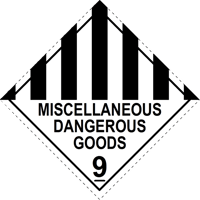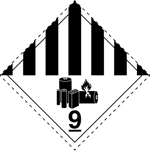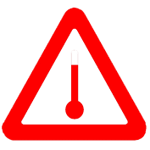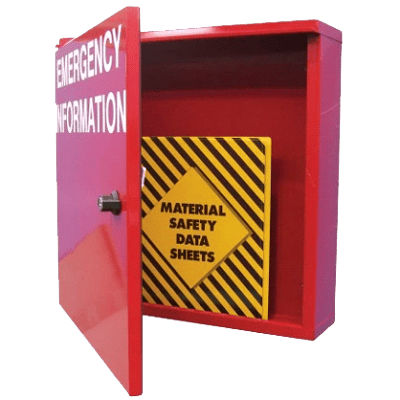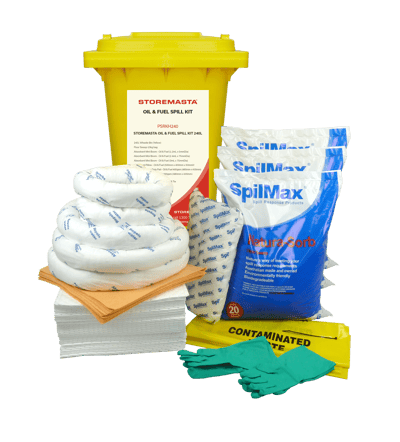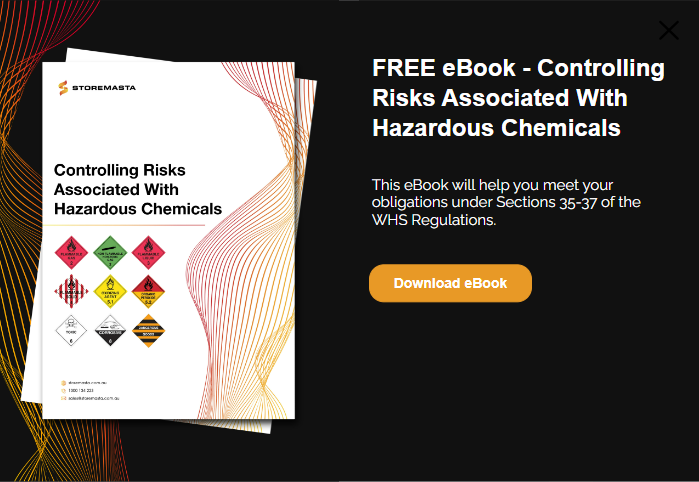According to the Australian Dangerous Goods (ADG) Code, Class 9 Miscellaneous Dangerous Goods are substances and articles which, when transported, present a danger or hazard not covered by the other eight dangerous goods classes. This diverse range of goods includes items such as lithium ion batteries, genetically modified organisms, life-saving devices and polymeric beads. This post offers a complete guide to the safe handling and storage of Class 9 Miscellaneous Dangerous Substances and Articles, with essential information that can be easily applied to any workplace in Australia.
Understanding Miscellaneous Substances and Articles
Edition 7.77, 2020 of the ADG Code explains that there are a diverse range of Class 9 substances and articles that fall under the miscellaneous dangerous goods category.
These include the following subdivisions of Class 9 substances and articles:
- Substances which, on the inhalation as fine dust, may endanger health
- Substances evolving flammable vapour
- Lithium batteries
- Capacitators
- Life-saving appliances
- Substances and articles which, in the event of a fire, may form dioxins
- Substances transported or offered at elevated temperatures
- Environmentally hazardous substances not covered by other classes
- Genetically modified organisms
- Amonium nitrate based fertilizers
- Other substances or articles presenting a danger during transport, but not meeting the definitions of another class
Globally, all miscellaneous dangerous goods and articles are classified by the UN Recommendations on the Transport of Dangerous Goods: Model Regulations - Twenty-first Revised Edition (2019).
The ADG Code — formally known as the Australian Code for the Transport of Dangerous Goods by Road & Rail — aligns with the UN Model Regulations. It also includes specific provisions that better reflect current Australian practices and conditions.
What Are Some Examples of Miscellaneous Goods?
A wide variety of Class 9 miscellaneous dangerous substances and articles are stored and handled in workplaces across Australia.
Some common examples of Class 9 dangerous goods found in Australian workplaces include:
- Airbag inflators and airbag modules
- Ammonium nitrate fertilisers
- Asbestos products (Blue, Brown or White)
- Battery-powered equipment
- Dry ice (solid carbon dioxide)
- First aid kits
- Fish meal
- Lithium batteries
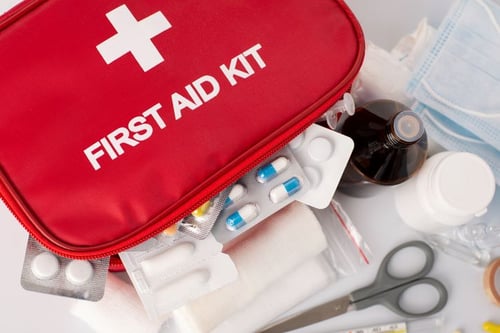
Class 9 miscellaneous dangerous substances and articles can be found in a wide range of workplaces and industries.
How Class 9 Miscellaneous Dangerous Goods are Subdivided
The ADG Code assigns all transportable substances (including mixtures and solutions) and articles to one of nine classes according to the main hazard they present. Some classes, including Class 9, are subdivided into several distinct divisions. However, keep in mind that the numerical order of the classes and divisions does not reflect the degree of danger.
Some dangerous goods are also assigned to one of the three UN Packing Groups in accordance with the degree of danger they present.
- Packing Group I: Substances presenting high danger
- Packing Group II: Substances presenting medium danger
- Packing Group III: Substances presenting low danger
Class 9 miscellaneous dangerous substances, including environmentally hazardous substances, are assigned to either Packing Group II or III (with the exception of some chemical and first aid kits).
Note that miscellaneous dangerous articles are not assigned to packing groups. However, specific packaging requirements are set out in the applicable packing instructions.
Class 9 Substances and Articles Subdivisions
| Proper Shipping Name | UN No. | Packing Gp |
| Substances which, on inhalation as fine dust, may endanger health | ||
|---|---|---|
| BLUE ASBESTOS (crocidolite) BROWN ASBESTOS (amosite, mysorite) AMPHIBOLE (actinolite, anthophyllite, tremolite) |
2212 | II |
| WHITE ASBESTOS (chrysotile) | 2590 | III |
| Substances evolving flammable vapour | ||
| POLYMERIC BEADS, EXPANDABLE | 2211 | III |
| PLASTICS MOULDING COMPOUND in dough, sheet or extruded rope form | 3314 | III |
| Lithium batteries | ||
| LITHIUM METAL BATTERIES e.g., rechargeable (lithium alloy) batteries | 3090 | II |
| LITHIUM METAL BATTERIES CONTAINED IN / PACKED WITH EQUIPMENT e.g., laptops, phones, cameras, power tools | 3091 | II |
| LITHIUM ION BATTERIES e.g., rechargeable (lithium ion polymer) batteries | 3480 | |
| LITHIUM ION BATTERIES CONTAINED IN / PACKED WITH EQUIPMENT | 3481 | |
| LITHIUM BATTERIES INSTALLED IN CARGO TRANSPORT UNIT e.g., lithium battery-powered vehicles | 3536 | |
| Capacitors | ||
| CAPACITOR, ELECTRIC DOUBLE LAYER with energy storage capacity > 0.3 Wh | 3499 | |
| CAPACITOR, ASYMMETRIC with energy storage capacity > 0.3 Wh | 3508 | |
| Life-saving appliances | ||
| LIFE-SAVING APPLIANCES, SELF-INFLATING | 2990 | -- |
| LIFE-SAVING APPLIANCES, NOT SELF-INFLATING containing dangerous goods as equipment | 3072 | -- |
| SAFETY DEVICES electrically initiated | 3268 | III |
| Substances and articles which, in the event of fire, may form dioxins | ||
| Examples include transformers, condensers and apparatus containing the following substances: | ||
| POLYCHLORINATED BIPHENYLS, LIQUID | 2315 | II |
| POLYCHLORINATED BIPHENYLS, SOLID | 3432 | II |
| POLYHALOGENATED BIPHENYLS, LIQUID HALOGENATED MONOMETHYLDIPHENYLMETHANES, LIQUID POLYHALOGENATED TERPHENYLS, LIQUID |
3151 | II |
| POLYHALOGENATED BIPHENYLS, SOLID HALOGENATED MONOMETHYLDIPHENYLMETHANES, SOLID POLYHALOGENATED TERPHENYLS, SOLID |
3152 | II |
| Substances transported or offered for transport at elevated temperatures | ||
| ELEVATED TEMPERATURE LIQUID, N.O.S. ≥ 100°C and < its flash-point - including molten metal, molten salts, etc. | 3257 | III |
| ELEVATED TEMPERATURE SOLID, N.O.S., ≥ 240°C | 3258 | III |
| Environmentally hazardous substances | ||
| Substances and mixtures dangerous to the aquatic environment and not classified elsewhere in Class 9 | ||
| ENVIRONMENTALLY HAZARDOUS SUBSTANCE, SOLID, N.O.S. | 3077 | III |
| ENVIRONMENTALLY HAZARDOUS SUBSTANCE, LIQUID, N.O.S. | 3082 | III |
| Genetically modified micro-organisms (GMMOs) and genetically modified organisms (GMOs) | ||
| GMMOs or GMOs are not subject to the ADG Code when licensed by the OGTR, approved by FSANZ, or exempt from such licences and approvals under the Gene Technology Act 2000 | ||
| GENETICALLY MODIFIED MICRO-ORGANISMS GENETICALLY MODIFIED ORGANISMS |
3245 | -- |
| Ammonium nitrate-based fertilisers | ||
| AMMONIUM NITRATE-BASED FERTILISERS, SOLID | 2071 | III |
| Other substances or articles | ||
| Other substances or articles presenting a danger during transport, but not meeting the definitions of another class | ||
| ACETALDEHYDE AMMONIA | 1841 | III |
| CARBON DIOXIDE, SOLID (DRY ICE) | 1845 | III |
| ZINC DITHIONITE (ZINC HYDROSULPHITE) | 1931 | III |
| DIBROMODIFLUOROMETHANE (Fire extinguisher agent) | 1941 | III |
| BENZALDEHYDE (Bitter almond oil) | 1990 | III |
| FISH MEAL (FISH SCRAP), STABILISED | 2216 | III |
| MAGNETISED MATERIAL | 2807 | III |
| CASTOR BEANS, MEAL, POMACE, FLAKE | 2969 | III |
| VEHICLE, FLAMMABLE GAS POWERED or FLAMMABLE LIQUID POWERED VEHICLE, FUEL CELL, FLAMMABLE GAS POWERED or FLAMMABLE LIQUID POWERED |
3166 | -- |
| BATTERY-POWERED VEHICLE or BATTERY-POWERED EQUIPMENT | 3171 | -- |
| CHEMICAL KIT (silver nitrate solution) or FIRST AID KIT | 3316 | I, II or III |
| AVIATION REGULATED LIQUID, N.O.S. | 3334 | -- |
| AVIATION REGULATED SOLID, N.O.S. | 3335 | -- |
| FUMIGATED CARGO TRANSPORT UNIT | 3359 | |
| DANGEROUS GOODS IN ARTICLES, MACHINERY, APPARATUS | 3363 | |
| PACKAGINGS DISCARDED, EMPTY, UNCLEANED | 3509 | |
| ENGINE, INTERNAL COMBUSTION< br> MACHINERY, INTERNAL COMBUSTION | 3530 | |
| ARTICLES CONTAINING MISCELLANEOUS DANGEROUS GOODS N.O.S. | 3548 | |
Are you searching for an answer to, ‘What is the Australian Standard for storage and handling of Miscellaneous Dangerous Goods?’
Standards Australia developed and maintain a Standard that sets out the requirements and recommendations for the safe storage and handling of dangerous goods and articles of Class 9, as classified by the UN Model Recommendations and listed in the ADG Code
This Standard, AS/NZS 4681:2000 The storage and handling of Class 9 (miscellaneous) dangerous goods and articles (AS 4681), covers these goods as transported in packages, intermediate bulk containers (IBCs) and bulk.
The Standard provides detailed guidelines for:
- Minor storage of Class 9 Miscellaneous Dangerous Goods
- Bulk storage and handling of Class 9 Miscellaneous Dangerous Goods
- Location, design and construction of stores
- Fire protection
- Waste disposal
- Operations
- Personnel safety
- Emergency procedures
- Class 9 - Miscellaneous Dangerous Goods Label
The warning label or placard used to identify Class 9 Dangerous Goods typically has seven black vertical stripes on a white background in the upper half of the label, with the figure 9 underlined in the bottom corner.
Class 9 - Miscellaneous Dangerous Goods signage label. Source: National Transport Commission
Variations of Class 9 - Miscellaneous Dangerous Goods signage labels. Source: National Transport Commission
Variations of the Miscellaneous Dangerous Goods label feature additional environmentally hazardous substance marks such as lithium batteries and dead fish.
Miscellaneous Dangerous Goods Not Covered by AS 4681
The following scenarios involving dangerous goods are not covered by the Australian Standard:
- The transport of Class 9 dangerous goods and articles covered by other regulations, rules and codes, such as the ADG Code
- The storage and handling of bitumen, which is covered by AS 1940
- The storage and handling of Class 9 dangerous goods and articles which are regulated only for air transport, including aviation-regulated liquids and solids
- Genetically modified micro-organisms (GMMOs)
- The handling of Class 9 dangerous goods and articles in Australian ports, which is covered by AS 3846
- The storage and handling of Class 9 dangerous goods (not intended for resale) on farms, which are covered by AS 2507
- Class 9 dangerous goods that are combustible liquids at quantities classified as more than minor storage, which are covered by AS 1940
Risks Associated With Miscellaneous Dangerous Goods
Dangerous goods, by their very definition, present a particular degree of risk to people, property and the environment due to their physical and chemical properties.
The level of risk and type of reaction associated with dangerous and hazardous substances and materials varies according to the Class and unique properties of the substance or material. Factors such as the quantity of the substance, its location and the properties of other nearby materials also need to be considered when evaluating the level of risk associated with the storage, handling and transport of dangerous goods.
How to Safely Store Class 9 Miscellaneous Dangerous Goods
If you regularly use or store dangerous goods in your workplace, it is vitally important that you store, handle and manage these materials in a manner that minimises the associated risks they present to people, property and the surrounding environment.
An example protocol may involve the following steps:
- Identify the relevant Dangerous Goods (DG) classification of the substance or article using resources such as the Class 9 Subdivisions table above, the ADG Code and the Australian Standards applicable to dangerous goods.
- Assess the quantity, location and storage facility to be used for the material:
- Does it qualify as minor storage or bulk?
- What are the design and construction attributes of the packing stores and how are they maintained?
- Refer to the applicable sections of the relevant standard - e.g., AS 4681 - to ensure you implement the right controls and adhere to the general safety requirements that will mitigate the specific risks and hazards associated with the dangerous goods in your workplace, including:
- Keeping dangerous goods and articles away from heat and potential ignition sources
- Ensuring packages are secure, marked appropriately and not prone to spillage
- Maintaining suitable waste disposal procedures
- Regularly inspecting the goods using suitably trained personnel
- Providing adequate training to personnel involved in the storage and handling of the dangerous goods
- Segregating incompatible dangerous goods
- Providing and maintaining appropriate personal protective equipment (PPE) appropriate to the operational requirements of the store
- Providing and maintaining first aid kits
- Meeting any special requirements for the storage and handling of specific types of dangerous goods, such as asbestos, ammonium nitrate fertilisers, lithium batteries and other environmentally hazardous substances covered by the Standard
Requirements for Minor Storage of Class 9 Dangerous Goods
The Australian Standard for the storage and handling of Class 9 (miscellaneous) dangerous goods and articles (AS 4681) outlines the criteria for classification as minor storage as well as the general storage conditions and special storage conditions for specific dangerous goods, including:
- Equipment containing explosives and pyrotechnic devices
- Elevated temperature liquids and solids
- Polychlorinated biphenyls (PCBs) and asbestos
- Dry ice (solid carbon dioxide)
- Ammonium nitrate fertiliser
- Polymeric beads and plastics moulding material
Requirements for Location, Design and Construction of DG Package Stores
The Standard (AS 4681) also sets out the requirements and recommendations for the location, design and construction of package stores for Class 9 dangerous goods and articles, including Class 9 Miscellaneous Dangerous Goods storage cabinets.
Criteria are provided for:
- The types of stores, e.g., room, enclosure, cabinet or building
- Separation distances to boundaries and protected places
- Design and construction - including lighting, ventilation, spillage containment, safety showers and eyewash stations, outdoor storage areas, and offices within a store
Requirements for Bulk Storage and Handling of Class 9 DG
The Standard (AS 4681) stipulates that the storage of Class 9 dangerous goods in bulk quantities must be in a container that fits the following criteria:
- A portable bulk container:
- An intermediate bulk container (IBC)
- A tank container complying with the requirements of the ADG Code / IMDG Code
- An approved demountable tank complying with the requirements of AS 2809.1 and AS 2809.4
- A fixed bulk container - a permanently positioned tank, hopper or silo that is filled and discharged in situ
Requirements and recommendations are also outlined for the design and construction, location and filling of bulk containers, as well as the requirements for bunds and compounds.
Emergency Management of Miscellaneous Dangerous Goods
Managing emergencies in the workplace requires adequate planning for emergencies, the maintenance of manifests, placarding, and a process for the management of spills and leaks. We’ll go through each of these requirements in detail below.
How to Store a Manifest
A manifest is a written summary of hazardous chemicals that are handled or stored at a workplace.
The Standard for the storage and handling of Class 9 (miscellaneous) dangerous goods and articles (AS 4681) specifies that a manifest must be provided and maintained. It must also be kept in a location known to the local fire brigade.
According to WHS regulation, it’s recommended that the manifest be kept in a red waterproof Hazmat Box and stored somewhere readily accessible to emergency responders.
Hazmat Boxes are specifically built for securing important emergency information, including the manifest of hazardous chemicals, safety data sheets (SDSs) and site emergency plans.
Manifest and Emergency Information Box
Placarding for Class 9 Miscellaneous Dangerous Goods
The Standard stipulates that Class 9 stores must be placarded so that the signage reflects the actual storage situation at any given time. If the storage situation changes, the placarding should be amended without delay.
The following signage must be displayed to meet regulatory requirements:
- Appropriate dangerous goods class labels, with sides measuring at least 250m
- A warning sign to prevent unauthorised entry
- Where applicable, a warning sign that prohibits smoking and other ignition sources, e.g., DANGER: NO SMOKING, NO IGNITION SOURCES
- Where applicable, warning signs indicating the presence of elevated temperature liquids
Managing Leaks and Spills of Class 9 Dangerous Goods
AS 4681 highlights the importance of preventing leaks and spills in the workplace. The requirements also detail the need for an immediate spill response, so that spills are controlled and cleaned up as soon as they are detected in the workplace.
Providing spill kits and maintaining secure, purpose-built storage facilities and containers for all dangerous goods is the most effective way to manage spills and leaks when they occur.
Bunding is an efficient and effective solution for handling, containing and decanting dangerous goods. Bunding products — such as spill containment pallets, IBC suitable bunds, poly drum handling items, portable bunds, bunded shelving, drip trays and floor bunding — all serve to mitigate against the risk of leaks and spills by safely containing any that occur.
To reduce the risk of financial liability due to non-compliance, you should select bunding products that conform to the Australian Standards and dangerous goods regulations.
Storing and Handling Class 9 Goods
We hope our complete guide on how to store and handle miscellaneous dangerous goods has helped you identify and understand how to manage these dangerous substances and articles in your own workplace. If you’d like to learn more about this topic, why not access our easy-to-read eBook?
Our eBook explains how to use the Hierarchy of Controls to control the risks associated with dangerous goods, including your Class 9 substances and articles. By accessing your free copy, you’ll be able to learn how to select the most effective risk control measures and implement all the required mandatory controls according to the current legislation.
For further assistance with compliance audits, risk assessments or dangerous goods storage solutions, you can also get in touch with our knowledgeable staff. We have experience working with all classes of dangerous goods including Class 9 Dangerous Miscellaneous Substances and Articles.
Joining the team as a Dangerous Goods Storage Consultant, Melissa Hampton became Storemasta's Marketing Manager in late 2021. With extensive knowledge and experience in chemical compliance, Melissa is responsible for leading the Marketing team and helping shape their marketing strategy. In her spare time, you can find Melissa hiking, swimming and enjoying the great outdoors in beautiful north-west Tasmania.
